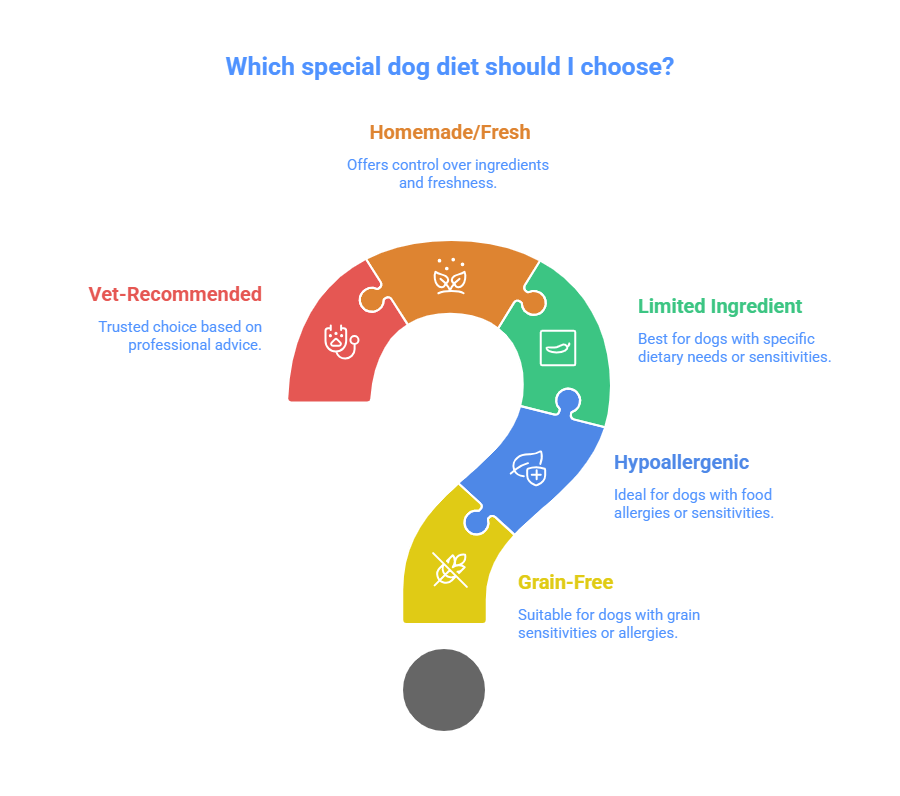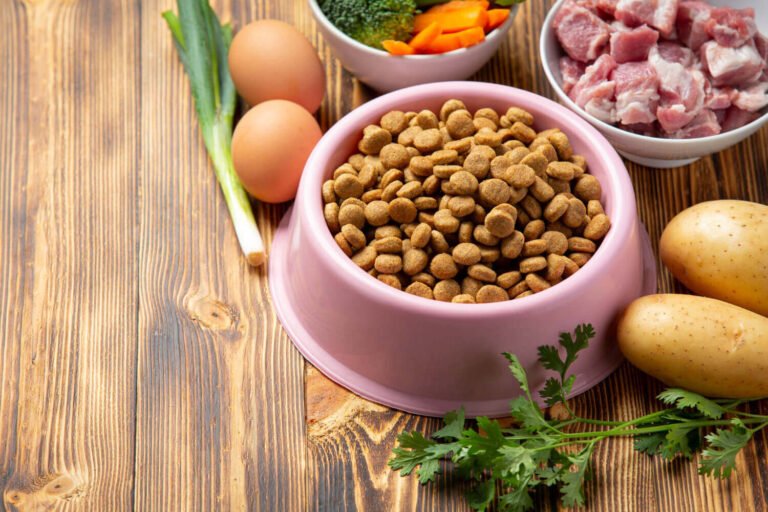Special Diets for Dogs Aren’t Just for ‘Sick’ Pets — Here’s Why That’s a Myth
Let’s clear this up right away:
Special diets for dogs aren’t just for pups with allergies, medical issues, or fancy vet prescriptions. That’s a common belief—and it’s way off the mark.
The truth? Many dogs thrive on tailored diets, even if they seem “healthy” on the outside. Whether it’s itchy skin, an upset tummy, or just being a picky eater, what we feed our dogs makes a huge difference. You don’t need to wait for problems to show up before exploring special nutrition plans. Prevention is just as powerful as treatment.
So if you’ve ever wondered why your dog keeps scratching, gets gassy, or just doesn’t seem satisfied after meals—this guide is for you. Let’s dive into why your dog might need a special diet and what you can do about it.
2.Why Some Dogs Need Special Diets (Even If They Seem ‘Fine’)
Not all dogs can eat the same food. Just like people, some pups have food sensitivities, allergies, or digestive issues that require a little extra care. Here are the most common reasons why a special diet for dogs might be the smartest move you’ll ever make for their health.
Food Allergies: When Dinner Turns Into a Problem
Not all dogs can eat the same food. Just like people, some pups have food sensitivities, allergies, or digestive issues that require a little extra care. Here are the most common reasons why a special diet for dogs might be the smartest move you’ll ever make for their health.
Food Allergies: When Dinner Turns Into a Problem
Dogs can develop food allergies at any age. It often starts small—like constant paw licking, itchy ears, or random rashes. Many pet parents chalk this up to fleas or seasonal allergies, but more often than not, the real culprit is their food.
Common triggers?
Chicken
Beef
Dairy
Wheat
Soy
Sound familiar?
This is where special diets for dogs with allergies come in. The goal is to eliminate the problem ingredient and replace it with something new—like novel proteins (think: duck, salmon, or kangaroo) or hydrolyzed protein diets, which break the proteins down so your dog’s immune system doesn’t overreact.
Here are some signs your pup may need a dog food for allergies:
Chronic itching or licking
Recurring ear infections
Digestive upset (diarrhea, gas, vomiting)
Inflamed skin or hives
Switching to a limited ingredient dog food can often help. These foods skip the fillers and focus on just one protein and one carb source to reduce risk of allergic reactions. Always work with your vet to do a proper elimination diet and identify the root cause.
Sensitive Stomachs: When Dog Food Doesn’t Sit Right
Let’s talk about dogs with sensitive stomachs. If your pup regularly has loose stools, excessive gas, or throws up now and then, they may need a special diet designed for digestion.
This isn’t about being a picky eater—it’s about comfort and health.
The usual suspects behind tummy troubles?
Sudden changes in diet
Rich or fatty treats
Food intolerance (like to corn or dairy)
Anxiety or stress
What can help:
Highly digestible dog food with fewer ingredients
Foods with prebiotics, probiotics, and gentle fiber (like pumpkin or rice)
Grain-free options (though talk to your vet first)
Some owners find success with low-fat dog food for dogs prone to pancreatitis or IBS-like symptoms. Others go for prescription dog food that’s made specifically for digestive care. Either way, the focus is on making digestion easier and more efficient.
Bonus tip: Try feeding smaller meals more frequently. It puts less stress on the digestive system and helps absorption.
Grain-Free Diets: Trendy or Truly Helpful?
The grain-free dog food trend exploded a few years ago—and with good reason. Many believed grains were the root of all allergies, bloating, and skin issues in dogs.
But is it really that simple?
Not exactly.
Here’s the deal: Some dogs do benefit from grain-free diets, especially if they’re allergic or sensitive to ingredients like corn, wheat, or soy. But not all grains are bad. In fact, whole grains like brown rice and oats can be super nutritious and easy to digest.
If your dog has:
Chronic itching
Ear problems
Runny stools
…it might be time to test a grain-free dog food. But do it smartly.
There have been concerns about canine heart disease (DCM) linked to grain-free formulas high in legumes like peas and lentils. That’s why it’s always best to choose a complete and balanced dog food that follows AAFCO guidelines—and chat with your vet before switching.
Grain-free isn’t a one-size-fits-all. For some dogs, it’s life-changing. For others, it’s unnecessary or even risky.
Other Special Diets You Might Not Know About
While allergies and digestion are top reasons to try special diets, there are others worth mentioning briefly:
Low-fat diets for dogs with pancreatitis
Prescription diets for dogs with kidney or liver conditions
Senior dog food with joint support and brain health
Weight management formulas for chubby pups
High-calorie puppy food for growing breeds
Homemade special diets for dogs (always vet-approved!)
Quick Reminder: Every dog is different. What works for one won’t work for all. That’s why finding the right special diet is more about listening to your dog’s body than following trends.
3.How to Choose the Right Special Diet for Your Dog

Most dog owners think picking a special diet is as simple as grabbing a bag labeled “for allergies” or “sensitive stomach.” But it’s not that easy.
There’s no magical one-size-fits-all food. What works for one dog might cause issues in another. Your job is to figure out your dog’s unique needs—and that takes a bit more than guesswork.
Start with a Vet Consultation (Always)
Before you swap foods, talk to your vet. They know your dog’s health history, and they can spot hidden issues that might be causing symptoms like:
Diarrhea
Chronic itching
Weight gain or loss
Lethargy
Vets may recommend prescription dog food for allergies, run allergy tests, or suggest an elimination diet for dogs to pinpoint the problem ingredients.
Understand What Type of Special Diet Is Needed
There are different kinds of special dog foods, depending on what your dog is going through. Here’s a quick cheat sheet:
| Dog Condition | Diet Type | Notes |
|---|---|---|
| Allergies | Limited ingredient, hydrolyzed protein | Avoid common allergens like beef, dairy |
| Sensitive stomach | Low-fat, easy-to-digest | Include prebiotics, probiotics |
| Pancreatitis | Prescription low-fat diet | Vet supervision needed |
| Kidney issues | Low-protein, low-phosphorus | Needs prescription food |
| Overweight | Weight-control dog food | Watch calories and treats |
| Puppies | High-calorie puppy food | Supports growth and immunity |
| Senior dogs | Joint-friendly, brain-boosting | Lower fat, more fiber |
Always check if the dog food meets AAFCO nutritional standards—look for the label.
Read the Ingredients (Not Just the Marketing)
Don’t get fooled by packaging that says “all-natural” or “holistic.” That’s just marketing. Flip the bag over and read the ingredients.
Look for:
Real meat listed first (chicken, salmon, duck, etc.)
No artificial colors or preservatives
No common allergens if your dog is sensitive
Clearly named sources (e.g., “chicken meal,” not “animal by-product”)
Avoid foods with vague terms like:
Meat by-product
Corn gluten meal
Artificial flavors
Transparency is key. You should know exactly what’s going into your dog’s bowl.
Trial and Observation (This Part’s On You)
Even the best dog food might not suit your dog. So once you make a switch, observe. Look for changes in:
Stool consistency
Coat shine
Energy levels
Itching or licking
Give any special diet dog food at least 4–6 weeks to show results unless symptoms get worse.
Pro Tip: Keep a food journal to track symptoms and reactions. It’ll help you and your vet find patterns fast.
Consider Homemade or Fresh Diets (With Guidance)
Some pet parents turn to homemade dog food for allergies or fresh dog food subscriptions. These options can be great—but they need to be balanced.
Dogs need the right mix of:
Protein
Carbs
Healthy fats
Vitamins and minerals
If you go this route, use a vet nutritionist or trusted calculator to avoid deficiencies.
You can check out BalanceIT—a vet-created tool for building homemade diets the right way.
4.Popular Types of Special Diets (With Pros & Cons)
There’s a whole world of special diets for dogs, and each comes with its own perks and potential pitfalls. Let’s break them down so you can make smarter choices based on your dog’s needs.
Limited Ingredient Dog Food
Perfect for: Dogs with food sensitivities or allergies.
Pros:
Fewer ingredients = less risk of triggering reactions
Often includes novel proteins (like duck or venison)
Cons:
May lack variety
Some are still loaded with fillers (check labels!)
Grain-Free Diets
Perfect for: Dogs with grain sensitivities or skin issues.
Pros:
Can help reduce itching or loose stools
Uses sweet potatoes or peas instead of wheat or corn
Cons:
Not all grain-free diets are healthy
FDA flagged possible link to DCM (heart issues) in some dogs
Best practice: Choose grain-free formulas with a balanced ingredient profile and consult your vet if concerned.
Prescription Dog Food
Perfect for: Dogs with chronic illnesses (like kidney or liver disease).
Pros:
Tailored for medical needs
Vet-approved for specific conditions
Cons:
Expensive
Requires vet authorization
Homemade Special Diets
Perfect for: Pet owners who want full control over ingredients.
Pros:
Great for dogs with multiple allergies
You control every ingredient
Cons:
Can lead to nutritional gaps if not formulated properly
Requires effort, time, and vet guidance
Fresh or Raw Dog Food (Controversial but Growing)
Pros:
Less processed
Often highly palatable
Cons:
Risk of bacterial contamination
Needs proper storage and sourcing
Raw diets should always be balanced and supervised—a lot of raw feeders fail to meet nutritional needs.
Want more info? PetMD’s Dog Nutrition Guides break it down by diet type, health condition, and life stage.
5.Best Commercial Dog Foods That Offer Special Diets
People often assume that premium dog food brands automatically mean “better.” But here’s the truth: price doesn’t always equal quality. What matters more is ingredient transparency, how well the food matches your dog’s specific needs, and whether it’s formulated by canine nutritionists.
Let’s dig into the best brands that offer reliable special diet dog food options.
Hill’s Prescription Diet – Vet-Recommended & Clinically Proven
Hill’s is a veterinarian-trusted brand known for its science-backed formulas. They offer diets for:
Food allergies (like z/d Skin/Food Sensitivities)
Kidney care
Gastrointestinal issues
Urinary health
Best for: Dogs with diagnosed medical conditions
Requires vet authorization
Royal Canin – Targeted Nutrition by Breed & Condition
Royal Canin makes prescription dog food for sensitive stomach and skin, plus breed-specific formulas.
Hydrolyzed Protein for food sensitivities
Selected Protein for elimination diets
Urinary and renal support lines
Best for: Dogs with multiple health issues
On the pricier side and needs a vet Rx
Visit Royal Canin USA
Purina Pro Plan – Affordable & Widely Available
Not all dogs need prescription food. Purina Pro Plan Sensitive Skin & Stomach is a great over-the-counter option made with salmon and no corn, wheat, or soy.
Best for: Mild sensitivities and picky eaters
Some recipes still include by-products (so read labels)
📎 Check options on Purina Pro Plan
Natural Balance – Limited Ingredient Diet Champions
Natural Balance is known for limited ingredient dog food with novel proteins like duck, venison, or salmon. Perfect for allergies or elimination trials.
Best for: Dogs with food intolerances or itchy skin
Not all formulas are grain-free, so double-check if needed
📎 Visit Natural Balance L.I.D.
The Farmer’s Dog – Human-Grade & Custom Plans
If you prefer fresh dog food for allergies or sensitive tummies, this one’s a hit. The Farmer’s Dog delivers freshly prepared meals based on your dog’s profile.
Best for: Owners who want ingredient control without cooking
Higher price point and needs fridge space
📎 Learn more at The Farmer’s Dog
Bonus Picks:
- Instinct Raw Boost (for raw food lovers)
Blue Buffalo Basics (for grain-free, limited ingredient diets)
Nom Nom (fresh, vet-formulated meals)
Pro Tip: Always transition to a new food gradually over 7–10 days to avoid tummy upsets.
6.DIY Special Diets: Homemade & Fresh Food Plans
Let’s be honest—commercial foods don’t work for every dog. Some pups need custom-made meals to avoid flare-ups, especially when dealing with multiple food allergies in dogs or digestive disorders. That’s where homemade special diets come in.
But here’s the catch: DIY doesn’t mean “toss in rice and chicken and call it a day.”
Why Go Homemade?
Homemade diets are great for:
Dogs with complex allergies or sensitivities
Owners wanting ingredient control
Dogs refusing kibble or commercial food
They allow full transparency—you know exactly what’s in the bowl.
What Should Be in a Balanced Homemade Diet?
Every homemade dog meal needs to include:
Protein (chicken, turkey, beef, fish)
Carbohydrates (rice, oats, sweet potatoes)
Healthy fats (olive oil, flaxseed oil)
Vitamins & minerals (either from whole foods or supplements)
It’s super important to avoid nutritional deficiencies—especially calcium, zinc, and B vitamins.
📎 Check out the tool BalanceIT (created by veterinary nutritionists) to build balanced home diets.
Tips to Safely Create Homemade Dog Food
Consult your vet or a veterinary nutritionist first
Use human-grade ingredients
Avoid toxic foods like onions, garlic, grapes, and chocolate
Use recipes from trusted sources only
Try batch cooking and freezing portions—it saves time and keeps things fresh.
What About Raw Diets?
Raw feeding is a growing trend, especially for dogs with chronic skin or GI problems. But it’s controversial.
Pros:
Less processed
Can improve coat, stools, and energy
Risks:
Potential bacteria (salmonella, E. coli)
Nutritional imbalances if not done right
If you’re considering raw food for dogs with allergies or sensitivities, work closely with a vet familiar with raw feeding.
Homemade Treat Ideas for Sensitive Dogs
Got a dog who loves treats but has a touchy tummy? Try:
Dehydrated sweet potato chews
Frozen banana + plain yogurt bites
Oven-baked salmon cookies (with oats + egg)
DIY treats = full ingredient control and no junk.
7.Common Mistakes to Avoid with Special Diets for Dogs
Even the most well-meaning dog parents can trip up when trying to improve their pup’s health with a special diet. If you’re not careful, these small missteps can undo all your good intentions. Let’s break down the most common mistakes so you can dodge them with ease.
Skipping the Vet Visit
We get it—Google is quick and free. But when it comes to something as important as your dog’s food, a veterinarian-approved special diet for dogs is the safest route. Self-diagnosing your dog’s food allergies or tummy issues can lead to more harm than good.
Pro Tip: Always ask your vet before switching to limited ingredient diets, hydrolyzed protein formulas, or grain-free dog food. Some conditions mimic food sensitivities but need different treatment.
Switching Foods Too Quickly
It might seem like a good idea to dive right into a new food, especially if your dog is struggling. But a sudden food switch can wreak havoc on your dog’s digestion—even with high-quality food for sensitive stomachs.
Take at least 7 to 10 days to slowly transition from the old food to the new one. Start with 75% old and 25% new for a few days, then 50/50, and finally 100% new food.
Believing “Grain-Free” Automatically Means Better
Here’s a big one: not all grain-free dog diets are healthier. In fact, some studies link grain-free diets (especially those heavy in peas and lentils) with heart conditions like Canine Dilated Cardiomyopathy (DCM).
Unless your vet tells you your dog needs to avoid grains, look for whole grains like brown rice or oatmeal in your dog’s food. They offer valuable nutrients and fiber.
Over-Relying on Trendy Ingredients
Quinoa? Chickpeas? Kangaroo meat? Trendy ingredients can sound healthy (and exotic), but they aren’t always the best fit for your dog. Sometimes, simple, vet-formulated diets are far more effective than those that just look nutritious on the label.
Focus on: Nutritional balance, digestibility, and AAFCO-compliant recipes—not marketing buzzwords.
Not Reading the Label Carefully
Pet food marketing can be sneaky. Just because it says “all-natural” or “holistic” doesn’t mean it’s suitable for dogs with food sensitivities or allergies. Always check the first 5 ingredients, the protein source, and whether it’s marked “complete and balanced” for your dog’s life stage.
Look for the AAFCO nutritional adequacy statement—it’s one of the most important lines on the package.
Ignoring Treats and Table Scraps
You might be feeding your dog the perfect special formula for food allergies, but if you’re handing out random treats or sharing your dinner, it could undo all the benefits.
Stick to hypoallergenic treats, and make sure every bite your dog gets aligns with their dietary needs. Even a tiny bit of cheese or chicken from your plate can trigger symptoms again.
Avoiding these mistakes can make a world of difference in how effective your dog’s special diet is. It’s not just about picking the right food—it’s about using it the right way.
FAQs on Special Diets for Dogs
Let’s clear up some confusion. A lot of dog owners have questions about putting their dogs on special diets, and it’s totally normal. Here are the most common ones we get asked:
How do I know if my dog needs a special diet?
Look for signs like:
Chronic itching, scratching, or licking
Repeated ear infections
Gas, bloating, or loose stools
Vomiting after eating
Poor coat quality or hair loss
Behavioral changes after meals
If any of these show up, talk to your vet. They might recommend a limited ingredient dog food or an elimination diet for food allergies.
What’s the difference between food allergy and food sensitivity in dogs?
Good question! A food allergy is an immune reaction—like red, itchy skin or swelling. A food sensitivity, on the other hand, usually causes digestive issues like diarrhea, vomiting, or gas.
Both can be managed with the right dog food for allergies and sensitivities, but the approach may vary.
Are grain-free diets really better for dogs with sensitive stomachs?
Not always. Grain-free sounds trendy, but it’s not automatically better.
Some dogs do great on grains like brown rice or oats. Others may react to them. Grain-free dog food is helpful only if your dog is actually sensitive to grains. Otherwise, you might be removing a perfectly healthy carb source for no reason.
Always get to the root of the issue before switching.
Can I feed raw food if my dog has allergies?
Usually within 6 to 12 weeks. If you’re doing a trial with hydrolyzed protein dog food or a novel protein diet, be consistent and patient. No treats, no scraps—just the food.
After that, your vet may help reintroduce ingredients to confirm what caused the issue.
Can puppies or senior dogs go on special diets too?
Absolutely. There are special diets for puppies with food allergies, and also senior formulas that help with joint care, weight control, or kidney health.
Just make sure it’s age-appropriate. For example, don’t feed a large breed puppy a low-cal senior formula—it may not meet their growth needs.
Are homemade diets safe long-term?
They can be, but only when properly balanced. Many DIY dog food recipes online lack essential nutrients.
If you’re going the homemade route for a special diet, use vet-approved recipes or tools like BalanceIT, and include a multivitamin supplement if needed.
What are novel proteins, and why are they used in special diets?
A novel protein is basically a protein your dog hasn’t eaten before—like duck, venison, kangaroo, or even rabbit. They’re used in special diets for dogs with allergies because your pup is less likely to react to something they’ve never had before.
Think of it like giving your dog a fresh start. If they’ve always eaten chicken or beef, switching to duck or fish can reduce flare-ups.
Is hydrolyzed protein dog food safe and effective?
Yes, and it’s often recommended by vets for dogs with severe food allergies. Hydrolyzed protein means the proteins are broken down into super tiny pieces so your dog’s immune system doesn’t recognize them as allergens.
It’s kind of like making the food “invisible” to the immune system. Brands like Hill’s Prescription Diet z/d and Royal Canin HP are popular vet-approved options.
Can a special diet help with my dog’s behavior issues?
Surprisingly, yes—sometimes. If your dog has chronic discomfort from food sensitivities or nutrient imbalances, it can affect their mood, sleep, and focus. A proper balanced diet for sensitive dogs can lead to calmer, happier behavior.
That said, not all behavior problems are food-related, so it’s always good to rule out medical or training issues too.
What are novel proteins, and why are they used in special diets?
A novel protein is basically a protein your dog hasn’t eaten before—like duck, venison, kangaroo, or even rabbit. They’re used in special diets for dogs with allergies because your pup is less likely to react to something they’ve never had before.
Think of it like giving your dog a fresh start. If they’ve always eaten chicken or beef, switching to duck or fish can reduce flare-ups.




